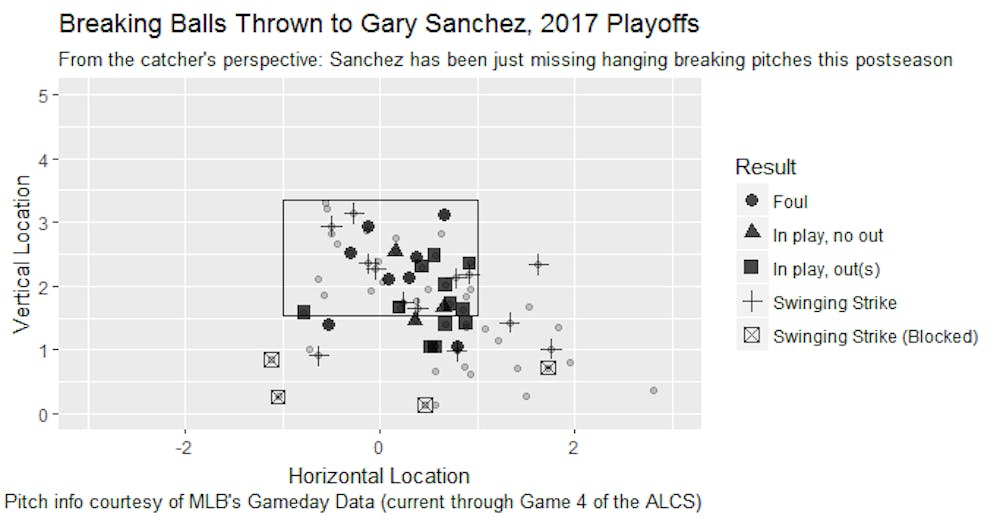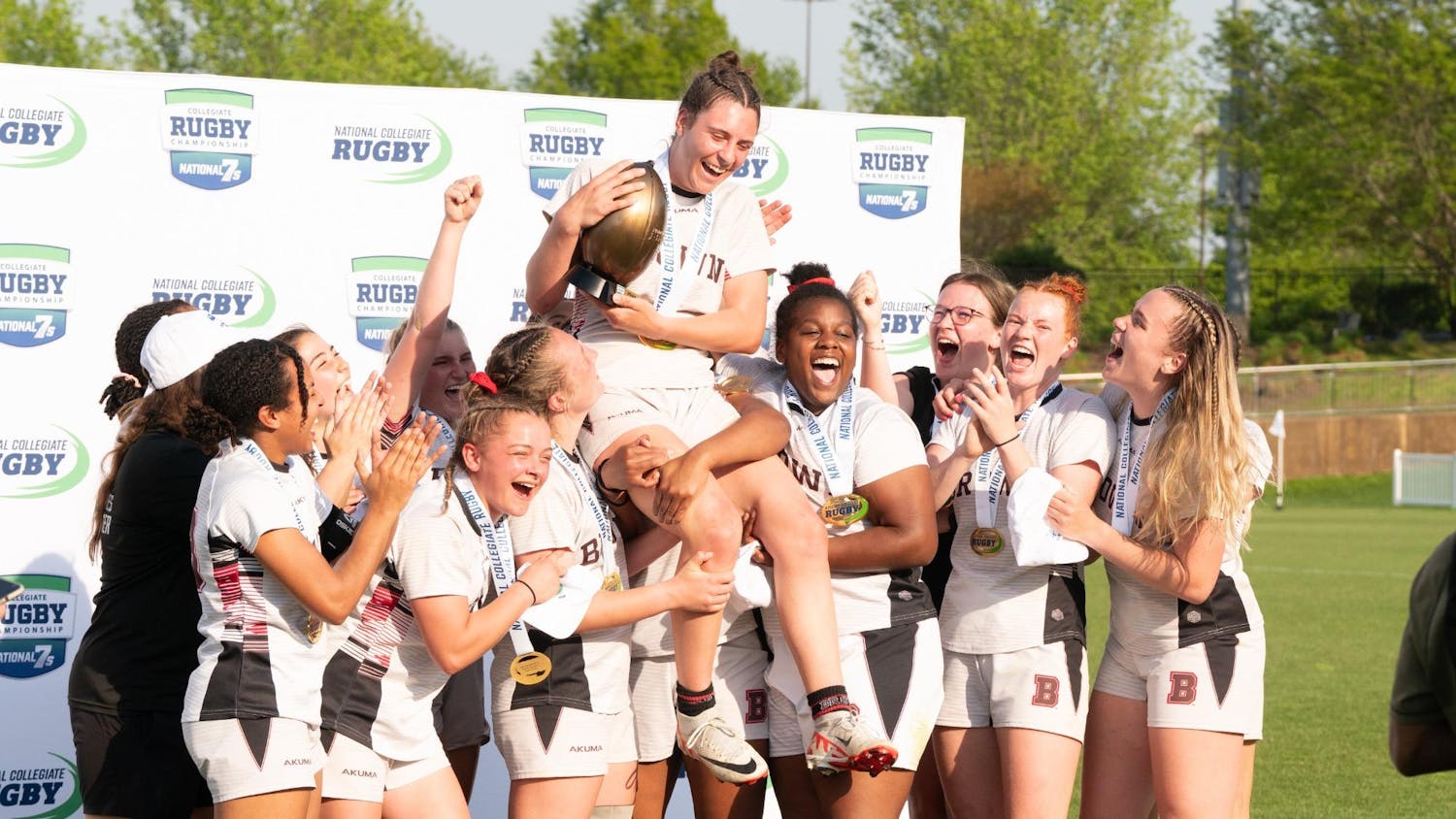Since he arrived in the big leagues at the beginning of August last season, the Yankees’ Gary Sanchez has been the best catcher in MLB, and it hasn’t really been close. Over the last two full seasons, only Buster Posey has accumulated more Wins Above Replacement than Sanchez: Posey leads 8.3 to 7.6 by Fangraphs’ WAR, but he has also played in 111 more games. During that same time frame, Sanchez’s weighted runs created plus, a measure of offensive performance, is 142 — meaning he has performed 42 percent better than league average at the dish — while no other catcher with more than 200 plate appearances has produced a wRC+ over 129. And for all the worry about his defense, Sanchez rates well by defensive runs saved at throwing runners out, and he has only been a touch below league average according to Stat Corner’s pitch framing metric.
Games four and five of the ALCS notwithstanding, that success has not translated to the playoffs. Even counting his recent two-game outburst, Sanchez has posted an anemic 62 wRC+ in 11 postseason games — a disastrous 38 percent worse than league average — and he has only reached base in a little more than 20 percent of his plate appearances, a 14-percentage-point drop below his career rate.
Surprisingly, Sanchez’s batted ball profile in the playoffs has changed very little from the regular season. Per Baseball Savant, Sanchez’s average exit velocity is down just 1.6 mph in the postseason to 89.1 mph, and his average launch angle of 13.5 degrees is only .2 degrees higher than it was from April through September. Still, Sanchez ran up a robust .379 expected weighted on-base average — a metric that bases hitter performance off only strikeouts, walks, exit velocity and launch angle — during the regular season, a figure that has dipped to .286 through game five of the ALCS, according to Baseball Savant.
Given Sanchez’s quality of contact thus far in the playoffs, that difference can be attributed to his playoff strikeout and walk rates, both of which have moved in the wrong direction since October. Sanchez has walked in just 2.1 percent of his plate appearances this postseason compared to 7.6 percent in the regular season, and he has struck out in an Aaron Judge-like 36.2 percent of his plate appearances, up from his regular season rate of 22.9 percent..
Pitchers have approached Sanchez differently in the playoffs, a factor that might be contributing to those unpleasant walk and strikeout trends. In the regular season, Sanchez saw 56.8 percent fastballs to go with 32.7 percent breaking balls, per MLB’s PITCHf/x data. So far in the postseason, pitchers have gone to a more even mix, throwing him just 48.7 percent fastballs along with 46.8 percent breakers. Considering Sanchez’s history, that adjustment might seem surprising. While he hit fastballs reasonably well during the regular season — ranking 52nd out of 144 qualified hitters in runs above average per 100 pitches against heaters — Sanchez thrived against sliders, ranking 33rd versus that pitch type, per Fangraphs’ pitch type linear weights model. Scouts must have looked at Sanchez’s dismal numbers against curveballs and decided to take their chances by throwing more breaking balls.
For the most part, that strategy has worked. As of this morning, Sanchez’s whiff rate is up nine-percentage-points against sliders and four-percentage-points against curveballs for the playoffs, in part due to poor pitch selection on the part of the Yankees’ backstop. Through game four of the ALCS, Sanchez has swung at 50 percent of the breaking balls thrown to him outside the strike zone, a figure almost nine-percentage-points higher than his regular season chase percentage, according to numbers derived from MLB’s PITCHf/x data.
But it’s not just the pitch mix that has been different against Sanchez in the postseason — pitchers are attacking him with strikes more often, too. Postseason hurlers have thrown their breaking balls in the strike zone 55.6 percent of the time, a seven-percentage-point jump from their regular season percentage. And their fastballs have found the zone 56.1 percent of the time this postseason compared to less than half the time during the regular year.
The graphics that accompany this article chart all the fastballs and breaking balls Sanchez has seen through game four of the ALCS, with the results of his swing attempts coded by shape. The charts show that pitchers have made many mistakes with both pitch types to him in the playoffs — Sanchez has simply failed to capitalize at his usual clip.
In the breaking ball plot, you can see that most of Sanchez’s contact has come on breakers down and away, while he has swung through or fouled off hangers up and over the plate. And in the fastball plot, you’ll notice a cluster of swinging strikes and foul balls versus heaters in the middle horizontal third of the dish. The effect of missing those pitches is twofold: Not only does Sanchez lose the opportunity to punish a mistake by the pitcher, but also it puts him into a worse count for the remainder of the at-bat. This point might be helpful for understanding why Sanchez’s strikeout rate has spiked in the playoffs. By fouling off or whiffing on hittable pitches rather than putting them into play with authority, Sanchez has been working himself into pitcher’s counts where he’s less likely to be successful.
Of course, games four and five against the Houston Astros highlighted what Sanchez can be when he’s locked in and crushing mistakes. In game four, Sanchez sprayed a fastball over the plate to right-center for a two RBI double, and in game five he hammered a pair of loopy breakers for a single and a home run.
To close out the Astros and take down the winner of the NLCS in the World Series, the Yankees could use that version of Sanchez.
Sam Grigo ’18 can be reached at samuel_grigo@brown.edu. Please send responses to this opinion to letters@browndailyherald.com and other op-eds to opinions@browndailyherald.com.




